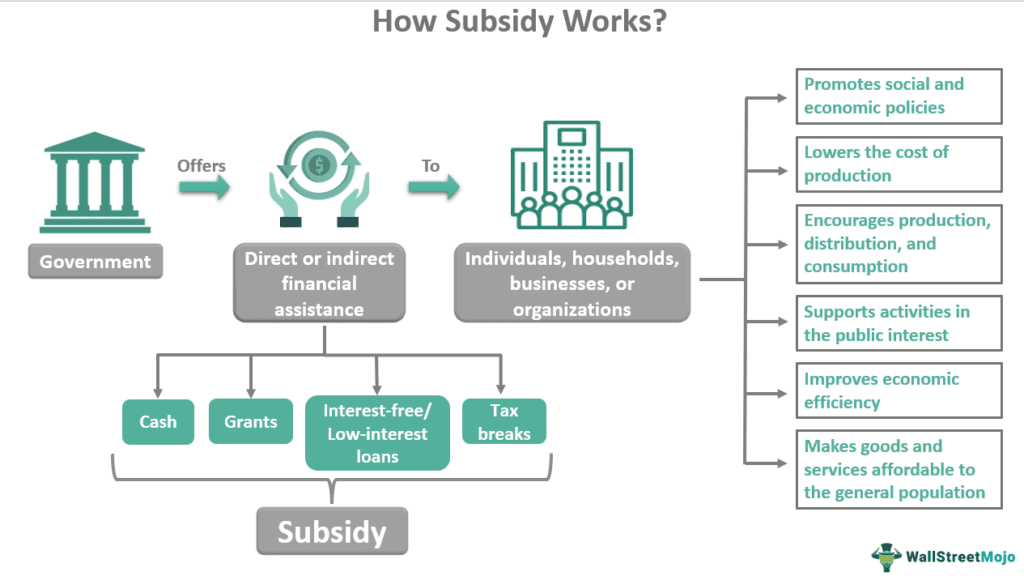Have you ever wondered how certain goods become more affordable for consumers and profitable for producers? Well, you’ll find out in this article.
Subsidies, a form of government intervention, play a key role in influencing product pricing and economic activity.
Let’s explore what subsidies are and how they impact the things we buy.
WHAT ARE SUBSIDIES AND HOW DO THEY IMPACT CONSUMER AND ECONOMIC BEHAVIOR?
Subsidies refer to a financial intervention given to an individual, business, or institution, usually by the government. It can be direct or indirect.
They can be direct like in student loans (cash) or indirect like in tax cuts or lower-cost raw materials. Subsidies are often offered for the betterment of society (eg student loans), protection of consumers (from rising living costs), protection of producers in certain struggling industries (e.g. farming), and sometimes for political gains, for example, push a country’s foothold in a certain product or industry (eg oil, energy). The goal of subsidies can be to support industries or to encourage new areas of growth. Hence they are not only offered for goods & products only but also for general welfare like food stamps, unemployment; or other public programs like free electricity, water, and free educational scholarships and grants. This article explains these concepts in further detail below.
How Does Subsidy Work?
A subsidy functions like a discount from the government. It aims to influence economic behavior by lowering the cost of production or consumption for specific goods or services.
Here’s an example: Corn Production
The government offers a subsidy to farmers and pays them a fixed amount per bushel produced. This lowers the overall production cost, potentially making corn more affordable for consumers and encouraging farmers to plant more.
Subsidies increase consumer spending which sometimes brings an economy out of a recession or depression. Goods are now affordable, consumers can live better and afford their mortgages. Overall, this keeps the economy functioning during challenging times.

Source: wallstreetmojo.com
IMPACTS OF SUBSIDY
-
The first impact of subsidies is the reduction in both production costs and the price of the commodity, making consumers buy more of that product.
-
The second impact of subsidies is that more firms will enter the market for subsidized products since it is now affordable for them to produce.
TYPES OF SUBSIDIES
Understanding the various types of subsidies is crucial for analyzing their impact on markets and economic behavior. They include:
Direct vs. Indirect
Direct Subsidies: These involve an actual transfer of funds from the government to a particular individual, group, or industry. This can take the form of:
- Cash Grants: Direct financial aid provided to recipients such as organizations.
- Tax Breaks: Reductions in the amount of taxes owed, to promote specific economic or social objectives.
- Low-Interest Loans: Loans provided by the government at below-market interest rates, lowering financing costs.
Indirect Subsidies: These involve implicit support measures that benefit the recipient without an actual transfer of funds. Examples include:
- Price Controls: Government-mandated price reduction that effectively makes the good or service cheaper for consumers.
- Tax Exemptions: Exempting specific goods or services from certain taxes, thereby reducing their overall cost.
Subsidies can be further categorized based on their target:
Production Subsidies: The purpose of this type of subsidy is to reduce the cost of producing goods or services, and increase its output.
Consumption Subsidies: Aims to make specific goods or services more affordable for consumers, promoting access and potentially stimulating demand.
Export Subsidies: Provide financial support to businesses exporting goods or services. The purpose of this subsidy is to enable more export activities (moving goods to other nations), thereby increasing the nation’s earnings, and creating substantial trade value to the economy.
Import Subsidies: An import subsidy is financial aid to importers of in-demand goods. It encourages the import of specific goods or services by lowering the cost of shipping, making them available to consumers for an affordable price. These subsidies might be more common in nations that lack available resources, like lumber or oil, to produce in-demand goods internally.
Employment Subsidies: Incentives are provided to businesses and companies to hire workers by reducing their labor costs, and making more jobs available in a country to reduce the unemployment rate. This essentially breeds a higher quality of living and increased economic output.
Research and Development (R&D) Subsidies: Government issues these subsidies to promote innovation by financially supporting research activities in businesses and universities.
PRODUCT SUBSIDY
A product subsidy is financial support given by the government aimed directly at making a particular good or service cheaper. Subsidies on products are subsidies payable per unitof a good or service produced or imported.
How A Product Subsidy Benefits A Product:
a) Affordable Goods: Product subsidies can make goods more affordable for consumers by reducing their final selling price, ensuring they remain accessible to a wider range of people.
b) Inflation Control: The government can give subsidies to offset production price fluctuations and ensure prices remain reasonable for consumers.
c) Moderation Of Supply And Demand: Product subsidies can incentivize businesses to produce more of a specific good because they reduce how much it costs to manufacture them. A decrease in production costs also can lead to an increase in the number of products available and better meet consumer demand.
d) Supports Specific Industries: Product subsidies help to support strategic industries deemed crucial for the economy or national security. This can help those industries become more competitive or encourage their development.
Drawbacks Of Product Subsidies:
Though product subsidies are beneficial, they also pose some challenges which include:
- Market Distortion: Subsidies can artificially lower prices, potentially harming unsubsidized competitors and distorting market efficiency.
Let’s look at an illustration:
Imagine there’s a town famous for its delicious homemade apple pies. The apple harvest this year is really bad, so apples become expensive. This makes it hard for the bakers to keep making pies at their usual price.
The town council decides to help the bakers by giving them a subsidy for every apple pie they sell. This means the government pays the bakers some money, lowering their costs. Now the bakers can afford to sell their pies at a more normal price.
Winners and Losers:
Winners: The bakers & Consumers
The bakers – They can keep selling pies without going out of business, and consumers – They can still enjoy apple pie at a reasonable price.
Losers: Apple orchard owners – They might have sold their apples for a higher price without the subsidy.
This is a simple example, but it shows how helping one group can affect another. In this case, the bakers benefit, while the orchard owners miss out on some potential profit.
-
Inefficiency: Subsidies can sometimes create an environment where businesses become reliant on government support and may not strive for innovation or cost-cutting measures.
-
Increased Taxes: Citizens may pay higher taxes to provide the money that a government uses for economic subsidies.
-
Government Budget Impact: Product subsidies are funded by taxpayers, so they can place a strain on government budgets, sometimes causing debt loans.
PRODUCT SUBSIDY Vs. PRODUCTION SUBSIDY
Both product subsidies and production subsidies aim to make specific goods more affordable, but they target different points in the economic chain.
Here’s a breakdown to clarify the distinction:

Table created by author.
Takeaway : In both cases, bread gets cheaper, but how it happens is different!
Note:
Sometimes, governments use subsidies not just for economic reasons, but also for cultural or social reasons. For instance, a town might subsidize a local theater company, even if the theater loses money. This is because the town values having a theater and the cultural activities it brings.
So, subsidies can have both positive and negative impacts. They can help some people or businesses, but they might also have unintended consequences. In some cases, these subsidies are removed when the negative impacts outweigh the positive impacts.
SUBSIDY REMOVAL
Subsidy removal refers to the process of a government ending its financial support for a particular good, service, or industry. In simpler terms, it means the government stops giving out discounts.
Reasons for Subsidy Removal:
The points here are similar to the drawbacks of a product subsidy discussed above. The reasons for subsidy removal include:
1 Fiscal Burden: Subsidies can be a significant drain on government budgets. Removing them can free up resources for other priorities, and alleviate fiscal deficits.
2 Market Distortion: Subsidies can distort market forces and create an unfair advantage for subsidized products. Removal aims to create a more level playing field, allowing market forces to determine their prices based on supply and demand path.
3 Promoting Efficiency: Some businesses become reliant on government support thereby not striving for innovation or cost-cutting measures. In such cases, the removal of subsidies can incentivize efficiency.
4 Removing subsidies helps correct overconsumption or overproduction of goods, leading to a more balanced and sustainable market equilibrium.
The decision to remove subsidies is often complex and requires careful consideration of its potential economic and social impacts.
Let’s see this simple and straightforward example:
Imagine you and your friends are splitting the cost of pizza. Normally, your friend pays extra to help out because you forgot your wallet. That’s kind of like a subsidy!
Subsidy removal is when your friend says, “Hey Simi, you gotta pay your fair share from now on.” The pizza (product) gets more expensive for you (consumer), but it’s fairer overall.
A breakdown of subsidy removal:
Before: The government provides financial assistance (subsidy) to lower the cost of goods or services (e.g., fuel, food, electricity).
During Removal: The government gradually or abruptly stops providing the subsidy. This can happen in stages or all at once, depending on the government policy.
After Removal: The price of the goods is no longer lowered by the government financial assistance. It rises to its true market value, which may be higher than what consumers were previously paying.
Impacts of Subsidy Removal:
1 Increased Prices: The most immediate impact is often a rise in prices for consumers as they now pay the full market cost. This is known as consumer impact.
2 Economic Effects: Subsidy removal can affect different sectors of the economy, mostly leading to the reallocation of resources. It might benefit producers who no longer face low-price sales, but it can also hurt industries reliant on subsidies to stay competitive.
3 Social Concerns: When prices go up, it can be harder for people with lower incomes to afford the things they need, especially if those things are cheaper because of government help (subsidies).
So, governments might need to create programs to help these people, like giving them money or vouchers to buy essential items. This helps to make sure everyone can still afford the basics, even when prices rise.
CONCLUSION
A subsidy is a direct/indirect benefit given to an individual, business, or institution, usually by the government to make the production of goods or services cheaper. A product subsidy makes goods affordable for consumers which in turn supports producers on their end.
Subsidy has its drawbacks that leads the government to make informed decisions about removing them to create a more sustainable economy and market equilibrium.
